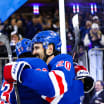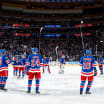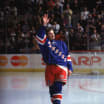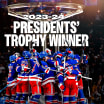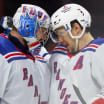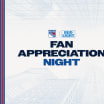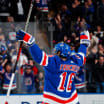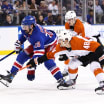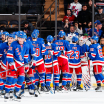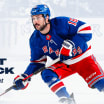The Rangers And New York - A 90 Year Love Affair
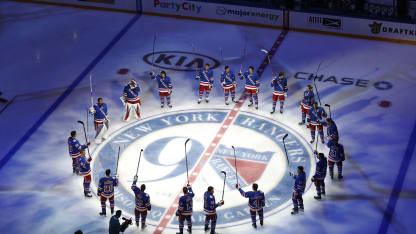
© Rana Faure
On the one side there was this brand, new hockey team, the Rangers, and on the other were 17,000 spectators who fell in love with the Blueshirts.
Oh, so sweetly, that affection remains more intense than ever as America's most famous hockey franchise celebrates its ninetieth anniversary.
That the brand, new sextet beat the defending champion Montreal Maroons 1-0 for its world premiere was merely icing on the cake. What mattered was that in no time at all the Rangers had become New York's darlings to fans and media alike.
"The Rangers were here to stay," wrote Eric Whitehead, author of The Patricks -- Hockey's Royal Family. "They had become a 'class' team."
But it was more than "class" that would endear the Blueshirts to New Yorkers, then and now. The club boasted character and characters; none more likable and approachable for more than twenty years than their leader, Lester Patrick.
Otherwise known as "The Silver Fox," Lester imprinted his regal character on the hockey club and the city he now called home. "Lester," said hockey executive Tommy Gorman, "didn't adjust to New York, New York adjusted to him."
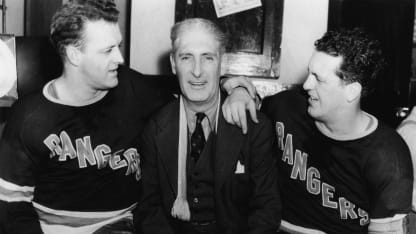
The direct connection between the Rangers and New York City was evident from the get-go. In just the second year of the club's existence, the Rangers won The Stanley Cup, defeating the Maroons. By that time, as Whitehead noted, Lester "had a knack too with the little people." He loved the fans and the vice was versa.
If there was any doubt how much New Yorkers already adored their new Champs it was evident as an overflow crowd roared its approval during the Cup celebration at City Hall Park. This feeling already had been established on opening night in 1926 when magnetic Mayor Jimmy Walker sat right behind the Blueshirts bench, rooting them to victory. So it was no surprise that "Beau James" toasted his team and its supporters in the shadow of Broadway's Woolworth Building skyscraper.
Whitehead: "Mayor Jimmy Walker was still preening in the afterglow of the colossal tickertape parade to hail the return of Charles Lindbergh. Now Walker was on the steps of City Hall with the Rangers, beaming and embracing Patrick as the crowd cheered and the flashbulbs popped."
As the seasons unfolded, so too did the inter-twining of the Rangers and New Yorkers and that included the cop on the beat. Typical was the friendship between Lester and Johnny Broderick, a police detective called "the toughest cop in New York." It was not unusual to see Patrick chatting with Broderick in the old Garden's rotunda before a game.
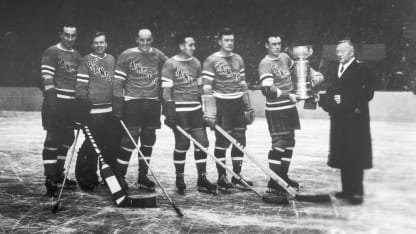
The Rangers required six more years before winning their second Stanley Cup; this time beating the Toronto Maple Leafs in the Spring of 1933. It wasn't just the regular man -- and woman -- on the street who were embracing the Blueshirts but New York's upper crust as well.
In addition to the usual City Hall celebration this time Garden executive Bill Carey hosted a sumptuous celebration at the Hotel Astor in Time Square. It was there that MSG's new president General John Reed Kilpatrick was introduced by Patrick and the two would remain close friends.
Thanks to that gregarious duet, the Rangers also became buddies with Broadway's vast show business community, as the club does today. Celebrities such as tunesmith and playwright Cole Porter as well as such headliners as Ethel Merman, Gertrude Lawrence, Humphrey Bogart and George Raft had become avid Rangers fans.
By the late 1930s the Blueshirts fan base had grown to even greater proportions when Patrick -- along with aide Tommy Lockhart -- installed the Rovers; an Eastern League farm team on to the Garden menu. Young fans -- myself included -- loved the Sunday afternoon double-headers featuring the Rovers. And most of us eventually graduated to the Rangers games played at night.
Eventually, the Old Guard, winners of the first two Cups -- featuring the likes of Frank Boucher, Bill and Bun Cook along with Ching Johnson -- gave way to a new breed. Lester's two sons, defenseman Murray and left wing Lynn, helped the Rangers win their third Cup in 1940. Meanwhile, Lester turned the coaching reins over to Boucher with excellent results.
Fans were especially enthralled by the six-game victory over the Maple Leafs in Toronto when they learned about Boucher's "secret weapon." Instead of the standard pre-game pep talk, the rookie coach herded his skaters to the Ford Hotel where they hoisted a pint or two. "It was," captain Art Coulter admitted after the Cup was won, "a good loosener!"
The Rangers further won the hearts of Gothamites at the start of World War II. Both of Lester's son, Murray and Lynn, were among the first NHL players to enlist in the U.S. Army while Cup captain Coulter joined the U.S. Coast Guard. By actual count, the Blueshirts lost more top players to the American and Canadian armed forces than any other big-league club.
Following the war an even closer bond between players and fans was forged with the formation of the Rangers Fan Club in 1950.
One of the most colorful and passionate members was cow-bell ringing Hilda Chester. During the Summer, she did her yelling for the Brooklyn Dodgers at Ebbets Field and when the hockey season began she rang her cow-bell for the Rangers.
Another Garden regular was interior designer Sally Lark. She sat shoulder to shoulder with the penalty bench, which, in those days, was shared by players of both teams. On any given night, Sally could be seen chatting with the skating sinners, including some members of the visiting team.
Balcony patrons, who sat more than 100 feet above the ice were a breed unto themselves. What better proof than the fact that they had their own entrance on 49th Street that lead to both the side and end balconies.
No fan was more dedicated nor passionate than former-FBI man Paul Gardella. He set an unofficial record, having seen more than 1000 consecutive games, despite blizzards, hurricanes and any other storm that hit the city.
As vice-president of the Rangers Fan Club in the early 1950s, I had the good fortune -- as did other RFC members -- to meet such Hall of Famers as Andy Bathgate, Gump Worsley, and Harry Howell among other Rangers.
Meanwhile a fourth edition of Madison Square Garden was being built atop Penn Station. When it opened during the 1967-68 season, it maintained its nickname -- The World's Most Famous Arena. Likewise, more and more famous hockey stars skated on its new ice. These included Rod Gilbert, Jean Ratelle and Vic Hadfield who comprised the superb GAG Line - as in Goal A Game.
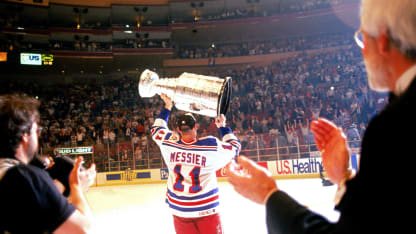
But no event coupled the Rangers to New York City more than the Mark Messier-inspired Stanley Cup triumph on June 14, 1994 and its aftermath.
The victory celebration on Cup-winning night actually was overshadowed in a sense by the mammoth parade down the city's Canyon of Heroes three days later.
"More than one million fans came out to salute the Rangers," wrote Tim Sullivan in Battle on the Hudson, "further illustrating just how far hockey had come to New York."
Nothing said it better about how the team and city intertwined than a comment by Rangers defenseman Kevin Lowe:
"I'll never forget a poster that I saw that day at the parade. It said it all. It was held by a little boy, and it said 'I thank you.' And ''My father thanks you.' And 'His father thanks you.' And I knew right then and there what it meant to so many families who have been following the Rangers through everything for all those years.
"When you're playing the game, and the series goes from one to the other, you're focused on hockey, hockey, hockey. But when you get a chance to step back, after the fact, and see things like that, it makes it so much more special."

The Cup win took place 22 years ago. Since then a new generation of Rangers rooters has sprouted; as faithful and passionate as ever. Typical is Brooklynite Antoinette Cammarano. Even though she was too young to remember the 1994 victory she echoes the thoughts of Blueshirts fans dating back 90 years:
"There's something about stepping into the Garden and feeling the electricity in the air before a game," she concludes. "it's like you can feel the stands thumping with the heartbeat of all the fans in attendance."
Then, a pause: "Nothing can compare with being a Rangers fan in The Garden."
Now, as it was then on November 16, 1926!

